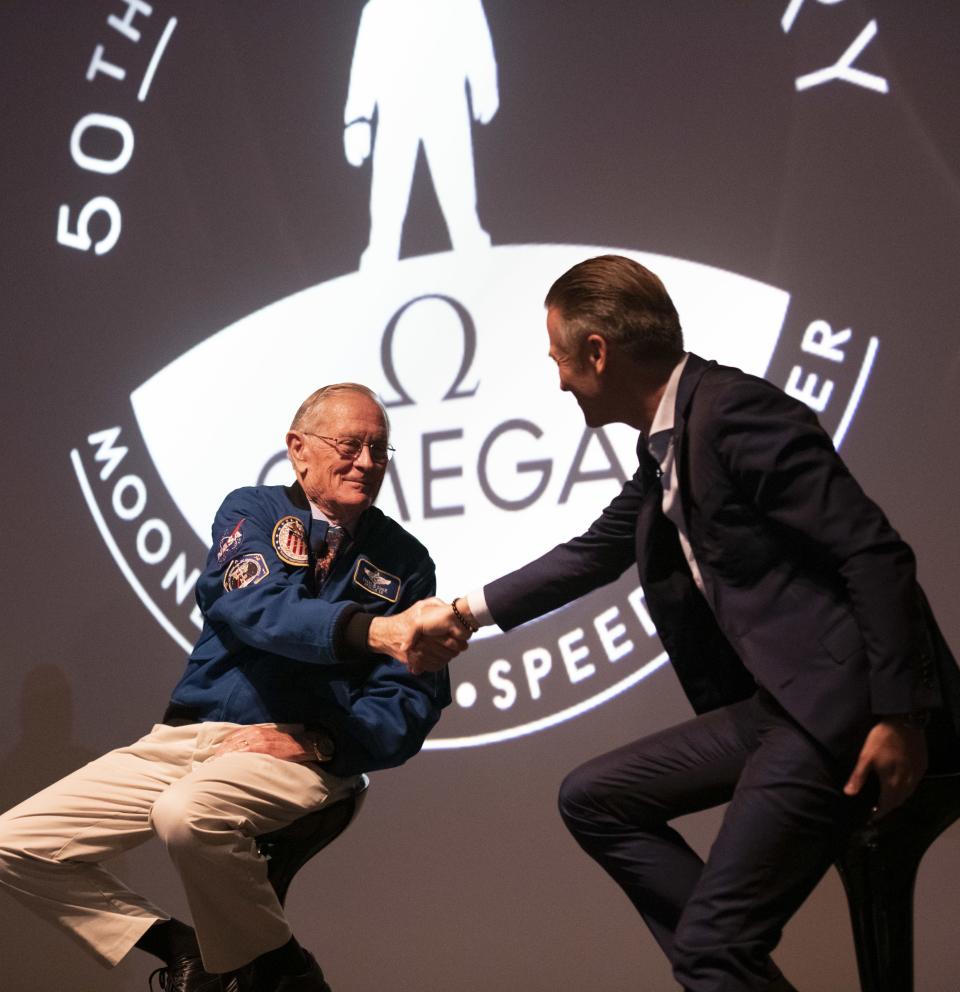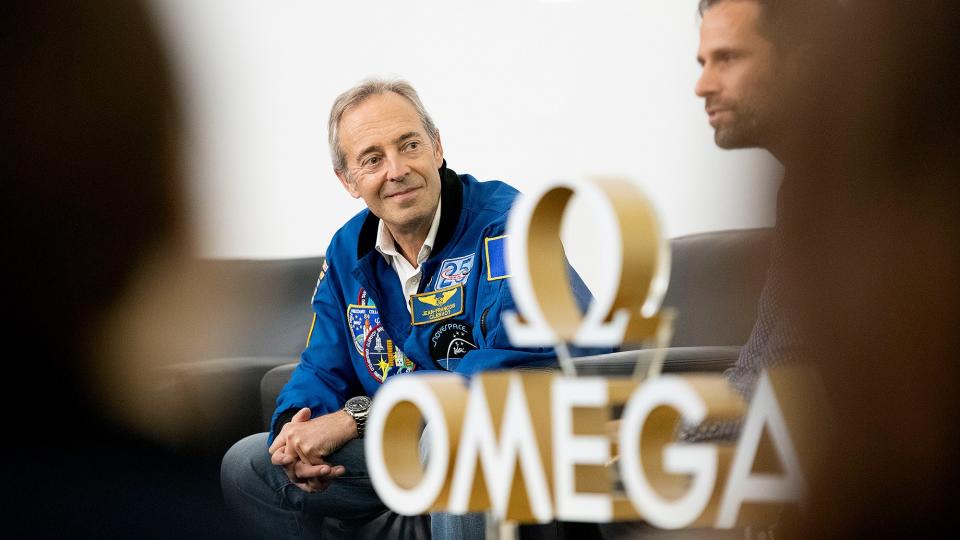Omega's Moonshot
Underneath the belly of the Saturn 5 rocket, the very one that helped 10 separate crews of astronauts escape our atmosphere and make those massive-for-mankind steps, George Clooney is having a hell of a time. He is joking around with his dinner mates inside a massive rocket-holding-hangar at Cape Canaveral, home to NASA. He’s here, seated at a table with real-life astronauts, in celebration of the watch brand Omega and its NASA-approved Speedmaster.
“How many gallons of fuel does this hold?” Clooney, pointing up at the massive rocket with pillars of light blaring out of its engine, asks Charlie Duke, former astronaut and the tenth man to walk on the moon.
“The first stage held four million pounds,” Duke replies.
“Four million pounds,” Clooney repeats, “and how many miles did you get up with that?”
“About 35 miles,” Duke answers.
A perfect set-up. Clooney, in full Bruce Wayne tux and greyed beard, can’t resist: “That's not good gas mileage.”

When Clooney is done charming he sits down to eat the same dinner as the rest of us: fat spears of asparagus, a choice of fish or steak, and a small cake made to look like the moon. More importantly, he’s wearing the same watch as practically everyone else in the room. It's the same watch that astronauts wore on their maiden voyages to space, and to the moon, that James Lovell used to safely navigate Apollo 13 back to earth, and that went out with the first American as he walked around without gravity into the great black beyond. I was wearing that watch, a grateful but temporary babysitter for the night. It’s the Speedmaster: a chronograph-enabled watch—originally built for race car drivers who wanted to precisely time their laps—that ended up in NASA’s hands, and eventually on the wrists of moon-bound astronauts.
Clooney’s is gold, modeled after the ones awarded during a victory-lap Houston dinner the Apollo 11 crew attended with the president to celebrate the successful moon mission in 1969. This year, Omega is selling 1,014 of those “Moonshine Gold” editions, the same amount sold 50 years ago. The one on my wrist is standard-issue stainless steel, but the back is engraved with the same phrase that's appeared on countless Speedmasters produced since 1969: “The First Watch Worn on the Moon.” Omega and its Speedmaster are proof that a watch brand—because collectors lap up mythical stories, red-white-and-blue-tinged nostalgia, and proven astronaut-grade quality—can be built largely on a single seven-word phrase. The watch market, both at retail and in the secondary market, is flourishing—in no small part thanks to customers obsession with things like honesty and storytelling and provenance. And what watch weaves a better yarn than one that went to the freaking moon?
When NASA engineer Jim Ragan rescued the Rolex from the thermal vacuum, he discovered the second hand had twisted closely against the minute hand like a vine climbing a tree. This was in the early ‘60s. John F. Kennedy had announced his mission of going to the moon before the end of the decade, and the newly-minted class of astronauts had requested wristwatches. There would be a digital clock in the cabin of the Apollo Lunar Module, but the astronauts were all military men, accustomed to reading and working with mechanical watches. Ragan was tasked with finding one that could survive the trip. So Ragan bought a Rolex, a Longines, and an Omega, and set about finding which ones were up to NASA’s standards.
He put together a gauntlet of tests, all designed to approximate some calamity the pieces might encounter in space. The first was the thermal vacuum, a chamber in which the temperature can be rapidly phased from 150º down to -150º. The first test knocked out both Rolex and Longines. (According to Gregory Kissling, Omega’s head of product management, many watch hands at that time were likely made of a combination of brass and steel and, because metals expand at different rates, that caused the Rolex and Longines to react screwy. That didn't stop some astronauts, like Apollo 14 crewmember Edgar Mitchell, from wearing their unsanctioned Rolex watches in space anyway.)
The Omega, on the other hand, passed all the tests, and was quickly cleared for space travel. Ragan first sent it up with the Gemini 3 crew in 1965, but the watch went unremarked upon. Three months later, on the Gemini 4 mission, Ed White became the first American to spacewalk and photographs of the achievement made it to the cover of Life magazine. You can still find them: there’s White in the foreground, and earth’s surface in the way, way background. Around the arm of his puffed-up astronaut suit is a black band with a watch.

Now, Ragan, inside a conference room at the Kennedy Space Center in Cape Canaveral, wearing a bomber jacket smothered with NASA-related patches, says the cover sent Omega executives scurrying to the phone.
“I got a call from Norman M. Morris, who was the sole distributor [of Omega] in the U.S., saying, ‘Was that our watch up there?’ They had no idea,” he says.
That moment would forever mint Omega’s reputation, clearing the runway for the brand to blast off. Watch houses are funny that way, the way their popularity can wax and wane based on a small step for man. The Omega Speedmaster went to the moon, almost everyone watched—when people who were alive for the occurrence say they remember exactly where they were when it happened Omega is a small part of that story.
And 50 years after the Apollo 11 crew—and Omega—landed on the moon, the brand is still working furiously to make the most of its participation in that history-making moment. In January, it announced plans to bring back the Caliber 321 movement that powered the moonwatches. That was followed by the release of the gold special-edition Speedmaster worn by Clooney. Then, in May, Omega released another anniversary watch with a black dial, “moon-gold” markers, and an image of Buzz Aldrin descending from the ship with his leg splayed out inside one of the sub-dials. (He was peeing!) Others, too, are cashing in on the moment. Sotheby’s organized an entire auction around moonwatches, Christie’s sold one of the original gold Speedmasters, and Phillips brought one used as a NASA guinea pig under the hammer.

“[The Speedmaster] is one of these watches where people come and say, ‘I want that one,’” Raynald Aeschlimann, Omega’s CEO, tells me. “They know about it—it's something that relates to their dreams. Everyone will talk to you and say [other watches are] iconic, iconic, iconic, iconic. Iconic is the worst word—but which watch has been an icon since 50 years and been part of this mankind historic achievement? Only one.”
Wrapping your brand up in the cape of historic achievement, it turns out, is highly effective marketing. “You can't look at Omega and NASA individually anymore,” says Rebecca Ross, a watch specialist with Christie’s. “They're intertwined with history. That's just such a great branding for them and it will live on forever.”
And there is more to Omega’s branding success than boomers getting weepy remembering the moon landing. NASA’s use of the Speedmaster is simultaneously a powerful seal of approval of the watch’s quality. “They're seen as watches has that can stand up to testing, and the accuracy is a massive deal for real collectors,” says Ross. “That's a major factor. Like the engine of a car—you want it to work and you want it to work well.”

But watch purchases are often emotional—the stories they tell as potent as their technical ability. Vintage watches dripping with sentimentality are coveted in the vintage market. Rolex’s marketing, for instance, relies on the feats of prisoners of war who used their chronographs to escape, or on the woman who crossed the English channel while wearing a Rolex as evidence of its waterproofness.
Omega has its own brand of nostalgia. When Robert-Jan Broer, the founder of watch magazine Fratello, was in college, he kept a car so that he could drive back and forth from school in the western part of the Netherlands to home, and his girlfriend, on the other side of the country. But when an Omega Speedmaster caught his eye, he sold the car to fund the watch purchase—and the start of his collection. “I felt it was worth it,” he says, “and the girlfriend didn't last anyway.”
Now, Broer is the originator of “Speedy Tuesdays,” a weekly Instagram occasion where people post Speedmasters. The beginning was purely random—“I just took a picture of my Speedmaster and I put it on Facebook,” Broer says, “and I wrote as a caption ‘Speedy Tuesday’ because, well, it's a Speedmaster and it was a Tuesday”—but now Speedy Tuesday has moved well beyond the grassroots. There are dinners and events for enthusiasts to meet up—”[Omega] takes care of the bill,” Broer says—and in 2017 Omega and Broer released a collaborative Speedy Tuesday edition of the Speedmaster. Naturally, that watch takes inspiration from the 1978 “Speedmaster Alaska III” model, designed specifically to make it easier for NASA astronauts to read the time in space.

Broer had fallen in love with Omega when he was younger, after seeing the watch brand on his father’s wrist. Dad bought one because he knew the history and passed it on like a fable to his son.”For some collectors it’s nostalgia. They were watching television when the moon landing was going on and for a lot of people it's a dream to be an astronaut,” Broer says. “It's like a superhero thing for certain people.”
When Neil Armstrong and Aldrin went to the moon’s surface and safely splashed down in the Pacific Ocean, they were instantly crowned American heroes with an amount of influence that would make Kim K blush. “Everything was about the space program,” Clooney says during a video with Aldrin. “We ate space food sticks and we drank Tang.” Average folk, like Clooney, wanted to be just like the astronauts—eating their food and wearing their watches.
For a brand like Omega, the achievement applies to more than just the Speedmaster. NASA approval is higher praise than any watch-testing body can provide. The brand is tied so closely to this magic little bit of Americana that it can use it to sell watches across the Omega catalog. It’s a strategy deployed by the most successful brands, but Omega’s laser focus helps. “To be tied to one, to just space alone, I think is better,” says Ross. “When you think of Omega, you instantly think of NASA and space. When you look at a Rolex there are 10,000 things in your head.”
In the ‘80s, though, Omega almost discontinued its most famous watch. A single model could not be the singular focus of an entire brand, and Omega needed to branch out. “It was a discussion on the management committee and they, finally after two or three years decided to keep it,” says Aeschlimann. “It resisted even then.” Aeschlimann is grateful for that. “There's not one watch that has more power in terms of its history and its design for representing Omega,” he says. “It's the Omegas of the Omegas.” The Speedmaster could get to space and back—but more importantly, it was able to navigate agilely through history.
Originally Appeared on GQ

